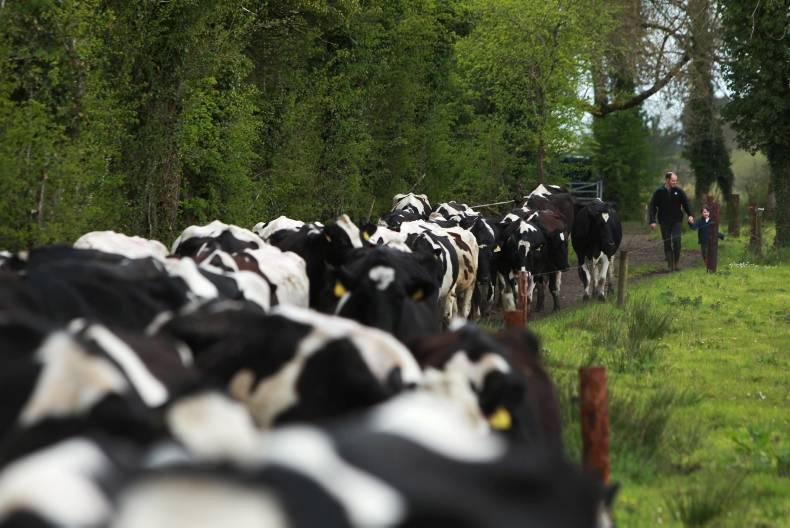“I can think of at least 10 very good reasons for co-ops to remain ambitious when setting the April milk price later this week and the peak milk prices over the next two months,” IFA national dairy chair Sean O’Leary said in a statement on Monday.
Reasons listed by the IFA include:
The 3% fall in the 2016/17 New Zealand milk output is being followed by questions being raised about supply in the new season beginning next month after recent storms.The Netherlands is reducing production capacity and supplies are remaining below last year’s levels in France and Germany.SMP is again being sold into intervention at an average of 920t per week, but this is reducing, with 885t sold in the last week of April. It is also far from over 15,000t per week that was sold this time last year.Fresh SMP supplies in the EU are well down, as processing has fallen back on year-earlier levels since last June and continued to fall 9.1% in January and February. SMP spot prices are just above intervention levels, but have increased by €20 to €40/t in the first week of May. EU average SMP prices increased €20/t to €1,770/t in the last week of April.Average EU butter prices breached €4,000/t last October and have continued to rise to a current EU average of €4,340/t.
All the main commodities relevant to the Irish product mix have seen price lifts in the last week of April to allow a milk price equivalent return (after 5c/l processing costs) of 31.13c/l (plus VAT). Four consecutive strongly positive GDT auction results, with price increases for butterfat, WMP, cheese and casein, suggest that international buyers are prepared to pay stronger product prices in the second half of the year. The latest GDT prices for SMP and butter would return a farmgate price of 31.14c/l (plus VAT).Asian dairy demand is vibrant, with Rabobank reporting that dairy imports in China are expected to rise by 20% this year and China prioritises EU origin imports for value-added dairy products. Vietnam is also seeing dairy demand increases of 7% per annum. Imports of EU cheese into Japan increased by 44% in January and February, with South Korea’s rising by 39%.Milk supplies have fallen in Argentina, Uruguay and Brazil, with Chile the only South American country showing growth of just 0.7% in January and February, meaning these countries are now significant importers of dairy products.NI milk prices
Meanwhile, in Northern Ireland, the Ulster Farmers’ Union has also called on processors to pass on market returns to farmers through increasing base prices for April milk.
“If dairy processors are serious about securing their supplier base in the future, they must demonstrate a willingness to pay their suppliers a sustainable milk price that accurately reflects the market,” said UFU dairy chair William Irvine.
Read more
Dairy markets: futures point the way for GDT rises
Continued decline in UK milk collections
“I can think of at least 10 very good reasons for co-ops to remain ambitious when setting the April milk price later this week and the peak milk prices over the next two months,” IFA national dairy chair Sean O’Leary said in a statement on Monday.
Reasons listed by the IFA include:
The 3% fall in the 2016/17 New Zealand milk output is being followed by questions being raised about supply in the new season beginning next month after recent storms.The Netherlands is reducing production capacity and supplies are remaining below last year’s levels in France and Germany.SMP is again being sold into intervention at an average of 920t per week, but this is reducing, with 885t sold in the last week of April. It is also far from over 15,000t per week that was sold this time last year.Fresh SMP supplies in the EU are well down, as processing has fallen back on year-earlier levels since last June and continued to fall 9.1% in January and February. SMP spot prices are just above intervention levels, but have increased by €20 to €40/t in the first week of May. EU average SMP prices increased €20/t to €1,770/t in the last week of April.Average EU butter prices breached €4,000/t last October and have continued to rise to a current EU average of €4,340/t. All the main commodities relevant to the Irish product mix have seen price lifts in the last week of April to allow a milk price equivalent return (after 5c/l processing costs) of 31.13c/l (plus VAT). Four consecutive strongly positive GDT auction results, with price increases for butterfat, WMP, cheese and casein, suggest that international buyers are prepared to pay stronger product prices in the second half of the year. The latest GDT prices for SMP and butter would return a farmgate price of 31.14c/l (plus VAT).Asian dairy demand is vibrant, with Rabobank reporting that dairy imports in China are expected to rise by 20% this year and China prioritises EU origin imports for value-added dairy products. Vietnam is also seeing dairy demand increases of 7% per annum. Imports of EU cheese into Japan increased by 44% in January and February, with South Korea’s rising by 39%.Milk supplies have fallen in Argentina, Uruguay and Brazil, with Chile the only South American country showing growth of just 0.7% in January and February, meaning these countries are now significant importers of dairy products.NI milk prices
Meanwhile, in Northern Ireland, the Ulster Farmers’ Union has also called on processors to pass on market returns to farmers through increasing base prices for April milk.
“If dairy processors are serious about securing their supplier base in the future, they must demonstrate a willingness to pay their suppliers a sustainable milk price that accurately reflects the market,” said UFU dairy chair William Irvine.
Read more
Dairy markets: futures point the way for GDT rises
Continued decline in UK milk collections






 This is a subscriber-only article
This is a subscriber-only article











SHARING OPTIONS: